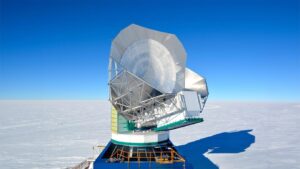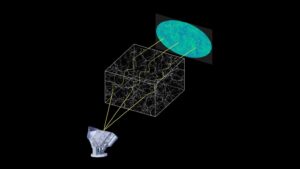Introduction: The Antarctic Frontier of Cosmic Discovery

In the remote reaches of Antarctica, where the icy winds whisper secrets of the universe and the polar night stretches endlessly, stands a bastion of human ingenuity and scientific exploration: the South Pole Telescope. Over the span of more than five years, this remote outpost has served as a beacon of cosmic inquiry, its solitary silhouette against the frozen horizon symbolizing humanity’s relentless quest to unravel the mysteries of the cosmos. Here, amidst the desolate beauty of the southern continent, scientists have undertaken a monumental endeavor – a quest to probe the deepest recesses of space and time in search of answers to the most profound questions that have captivated the human imagination for millennia.
Within the pristine expanse of Antarctica, far from the distractions of civilization, the South Pole Telescope stands as a sentinel of knowledge, its sleek form cutting through the icy silence of the polar landscape. From its vantage point at the bottom of the world, the telescope peers into the depths of space, offering glimpses of distant galaxies and ancient light that have traveled billions of years to reach our eyes. Here, amidst the isolation and solitude of the frozen continent, scientists labor tirelessly, driven by an insatiable curiosity and a boundless sense of wonder. For them, each observation is a triumph, each discovery a testament to the indomitable spirit of human exploration. And as they continue their quest to unlock the secrets of the universe, they stand as pioneers on the frontier of discovery, charting new horizons and pushing the boundaries of human knowledge ever further.
Pioneering Cosmic Exploration: The Quest for the Cosmic Microwave Background
At the heart of this audacious venture lies the cosmic microwave background (CMB) – the faint echo of the universe’s birth, reverberating across the eons since the dawn of time. To capture this ethereal signal, scientists have deployed an instrument of unparalleled precision and sensitivity: the SPT-3G camera. With its array of 16,000 detectors finely tuned to detect the faintest whispers of radiation, the telescope stands as a testament to humanity’s insatiable curiosity and our unwavering commitment to unlock the secrets of the cosmos. Each photon captured by the SPT-3G is a messenger from the distant past, carrying with it clues about the origins and evolution of the universe – a cosmic time capsule waiting to be decoded by the keen minds of astrophysicists and cosmologists.

In the relentless pursuit of understanding, the scientists operating the South Pole Telescope sift through the vast cosmic data collected by the SPT-3G, meticulously analyzing each signal and extracting valuable insights into the nature of the cosmos. With each observation, they peel back the layers of the universe’s history, piecing together a narrative that stretches from the fiery crucible of the Big Bang to the intricate web of galaxies that populate the cosmos today. It is a journey of discovery and wonder, where every observation is a revelation, and every breakthrough brings us closer to unraveling the deepest mysteries of existence. As they gaze into the depths of space and time, the scientists at the South Pole Telescope stand on the forefront of human knowledge, pushing the boundaries of what is known and delving into the unknown with courage and determination.
Unveiling the Veil of Darkness: Gravitational Lensing and the Nature of Dark Matter
Among the myriad phenomena observed by the SPT-3G, few hold as much promise and intrigue as gravitational lensing – a celestial dance in which the very fabric of spacetime is sculpted by the gravitational pull of cosmic giants, bending light rays and distorting the cosmic panorama. It is through this lens, both literal and figurative, that scientists seek to peer into the heart of darkness itself – the enigmatic realm of dark matter. Invisible and elusive, dark matter shrouds the cosmos in mystery, its presence betrayed only by its gravitational influence on the luminous tapestry of stars and galaxies. By studying the subtle distortions in the cosmic microwave background caused by gravitational lensing, researchers hope to unravel the secrets of dark matter – a substance that constitutes the vast majority of the universe’s mass yet remains invisible to conventional detection methods.
As astrophysicists and cosmologists delve deeper into the mysteries of dark matter, they are confronted with profound questions about the fundamental nature of the universe. What is the true composition of dark matter, and how does it interact with the ordinary matter that forms the building blocks of galaxies and stars? What role did dark matter play in the formation and evolution of cosmic structures, from the first primordial seeds of matter to the sprawling cosmic web that spans the universe? These are the questions that drive scientific inquiry forward, propelling researchers to explore new frontiers of knowledge and push the boundaries of our understanding of the cosmos. Through the lens of gravitational lensing and the sensitive detectors of the SPT-3G, scientists aim to unlock the secrets of dark matter, shedding light on one of the most enigmatic and elusive phenomena in the universe.
A Journey into the Unknown: Charting New Frontiers of Discovery
As the first measurements of CMB gravitational lensing trickle in from the frozen wastes of Antarctica, they offer a tantalizing glimpse into the cosmic tapestry – a vast and intricate web of matter and energy that spans the breadth of space and time. Yet, even as we marvel at the wonders revealed by the SPT-3G, we are reminded of the boundless expanse of the unknown that lies beyond. With each new dataset, each fleeting glimpse into the cosmic abyss, we are propelled ever further on our journey of discovery, driven by an insatiable thirst for knowledge and understanding.
Conclusion: Illuminating the Shadows of the Cosmos
In the depths of space, where darkness reigns supreme and the light of distant stars flickers faintly against the void, humanity has embarked on a quest unlike any other – a quest to unravel the mysteries of the universe and glimpse the very fabric of reality itself. Through the lens of the South Pole Telescope, we peer into the heart of darkness, seeking answers to questions that have haunted us since time immemorial. And though the journey may be long and arduous, filled with uncertainty and peril, we press on, guided by the beacon of curiosity that burns bright within us all. For in the end, it is not the destination that matters, but the journey itself – the journey into the unknown, where every discovery brings us one step closer to the truth.
Related Topics:
- Unveiling the Climate Crisis: Understanding the Urgency and Complexity of Climate Change – Micro2media
- Introduction: Understanding the Resilience of Kelp Forests During the 2014-2016 Pacific Marine Heatwave – Micro2media
- Dark Matter Comes Into Focus With Groundbreaking Antarctic Research
- Mimas’ surprise: Tiny moon of Saturn holds young ocean beneath icy shell | ScienceDaily
